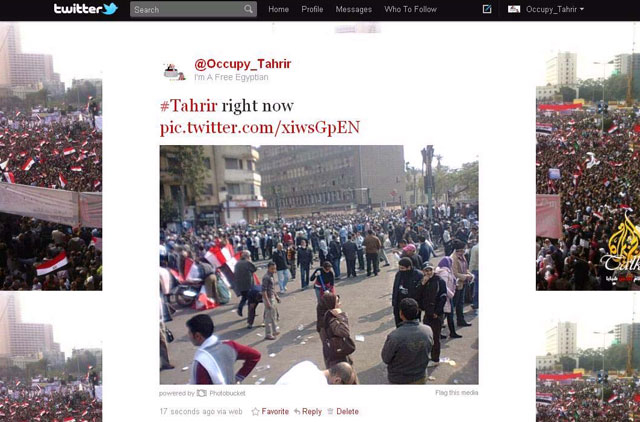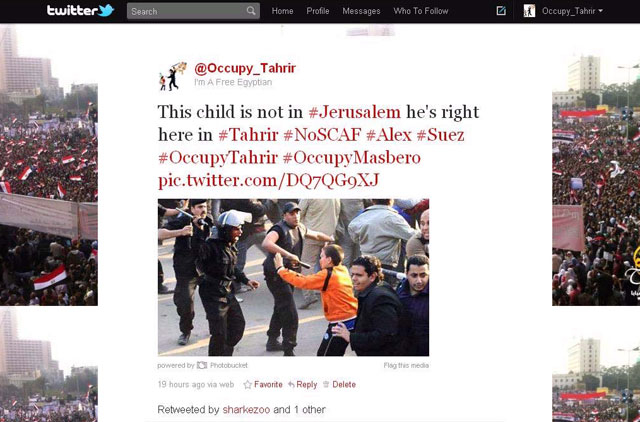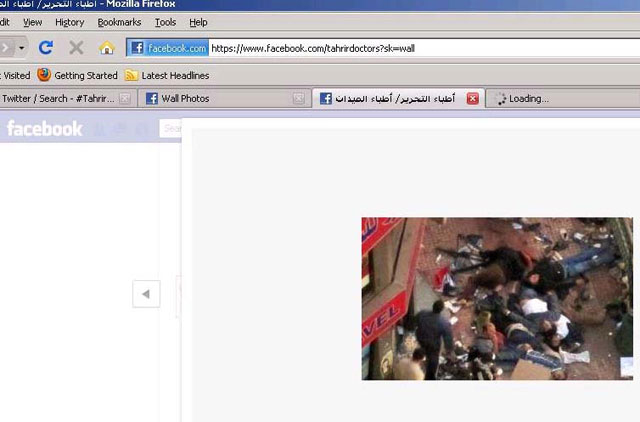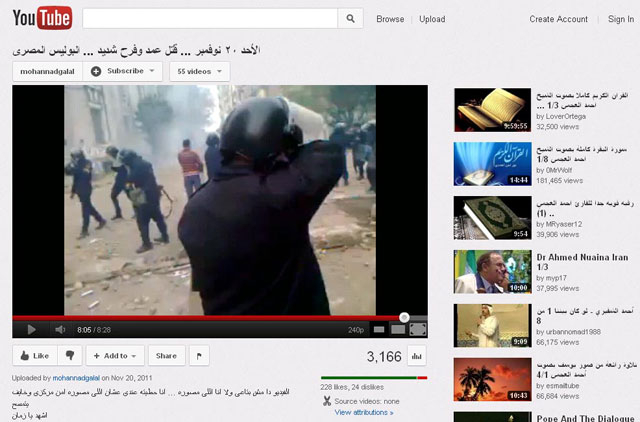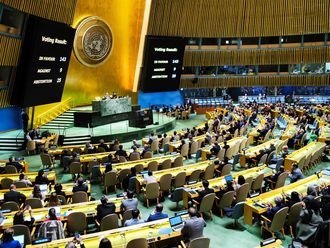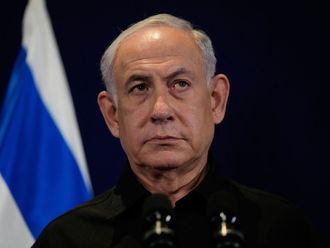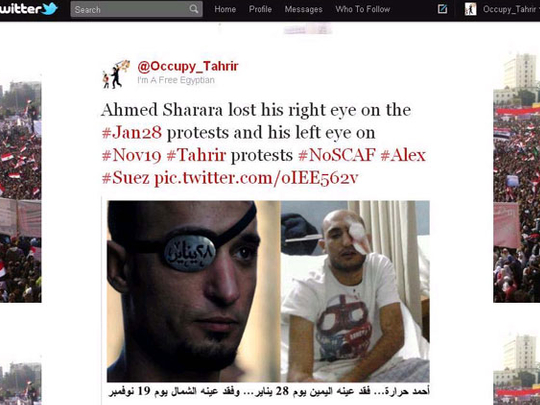
Dubai: The revived revolution in Tahrir Square has seen at least 1,500 injuries in just a few days since it erupted on November 19; hospitals treating protesters see patients with the same injury: wounded eyes. The Interior Ministry’s Central Security Forces is intentionally aiming rubber shotgun pellets and tear gas at the protesters’ heads, according to an article from the privately-owned Egyptian newspaper, Al-Masry Al-Youm. Speaking to AP, Ghada Shahbender, a member of the Egyptian Organization for Human Rights, said that the order to target their heads is a crime. Protesters in Tahrir Square share their videos in which military personnel can be heard receiving orders to aim for protesters' eyes. One patient at the International Eye Hospital in Egypt is an activist known as Ahmad Harara, who lost sight in his right eye on January 28 after pieces of shotgun pallets got wedged in his eye. On November 19 Harara re-joined his protesters in Tahrir Square, only to get injured in his second eye, but he voiced no regret, according to Al-Masry Al-Youm.
Chomsky's dire predictions for Egypt ring true
Dubai: "The US and its allies will do anything they can to prevent authentic democracy in the Arab world,” said Noam Chomsky, world renowned political analyst, in April 2011 about America's role in the region. He was talking at an event in New York in April. The video of that speech has now gone viral on social media networks. Chomsky underscored a specific “game plan” the US has followed with the Arab Spring, one that is regularly used, even with Egypt's erstwhile leader Hosni Mubarak. According to Chomsky, the US strategy is as follows: If a favoured dictator is in trouble, give him full support for as long as possible. If the army turns against the dictator, for example, this is when it becomes impossible to continue supporting him. The next step is to "send him off somewhere". Then they would declare their support for democracy. The final stage is "restoring the old regime" with new names. The US’s main goal is to ensure that a government that supports people’s demands is not formed, as much of the Middle East’s population view the US as a threat.
Egyptian protesters death toll hits 33 on third day
Dubai: The death toll from clashes between protesters and police around the country over the past three days has climbed to 33, morgue officials told AFP on Monday. Meanwhile, British Foreign Secretary William Hague said Monday that the outbreak of violence in Egypt was worrying but denied it showed hopes were fading for democracy in the Arab world. Hague was speaking to BBC Radio. He ruled out a call to the army to bow to protesters' demands, and hand over to an "unformed" civilian administration. The European Union's foreign policy chief Catherine Ashton also said in a statement she was "extremely concerned" about violent clashes: "I urge calm and restraint and condemn the use of violence in the strongest terms," adding "all parties concerned have the crucial task of listening to the people and protecting their democratic aspirations." Meanwhile Germany appealed for calm in Egypt, saying the violent clashes in the country were of great concern: "The Egyptian people have in recent months continuously pressed for democratic progress in their country. This must not now be put in jeopardy."
The first Egyptian revolution - ouster of Mubarak
Dubai: Protests started in Egypt on January 25 this year, inspired by the successful Jasmine Revolution in Tunisia. That day thousands of people took to the streets to protest poverty, unemployment, corruption and autocratic governance by President Hosni Mubarak, who had ruled the country for 30y years. Clashes broke out in Cairo's Tahrir Square between police and protesters, unrest spread and the army was deployed. Mubarak after days of clashes, sacked his cabinet, but defended the actions of the security forces. On February 1, huge rallies took place, in another televised address, Mubarak announced that day, that he would step down after September's presidential elections, promising constitutional reform. Protesters refused saying he should step down by February 4. Mubarak finally resigned on the eighteenth day of the protests, February 11. According to rights watchdog 684 Egyptians were killed and more than 5000 injured in this uprising.
'Tahrir Square Doctors' defy all odds
Dubai: Tahrir hospital was put together during the first revolution that ousted erstwhile Egyptian president Hosni Mubarak, by a group of volunteer doctors and medics, known as 'Tahrir Square Doctors'. Having witnessed the Egyptian police’s brutality, doctors, nurses, and medicine students gathered all the medical supplies and equipment they could carry and headed to Tahrir. Some were injured, some were killed, but most managed to deliver the medical help needed during the 18 days of revolution. Nine months later, the same doctors now find themselves back at the square, facing the same carnage, dealing with injuries caused by rubber bullets and live ammunition unleased by the Egyptian armed forces. According to Jazeera Live yesterday, the security forces stormed the square in an attempt to clear it, destroying every field hospital in Tahrir . Instead of giving up, the doctors as well as the protestors guarding the hospitals called for aid, and reestablished their hospitals inside Dobarah Church and Omar Makram Mosque located a few metres away.
Social Network a revolutionist tool in Egypt
Dubai: Social media again comes to serve the Arab spring. This time from Egypt, from Facebook, Twitter, Tumblr, Wordpress, to Youtube, all have been used by young enthusiastic protestors. Some to document and spread news, or to request aid when needed. Hash tag #TahrirTranslate, being the latest means by which activists foil the Egyptian military government's attempt to censor the flow of information coming out of Tahrir Square, Alexandria, and Suez. Hash tag serves as an instant translator for any given tweet coming out of Egypt, to ensure wide exposure of the events taking place. Besides keeping the world informed, movements also use social media to call for marches - the Youth Coalition and 6 April called today for the march of millions to Tahrir tomorrow at 4pm. Meanwhile activists and supporters flooded all channels with their comments over the Muslim Brotherhood's blatant abandonment, as well as the army's unprecedented brutality against protestors.
Egypt into a second revolution
Dubai: Egypt's revolutionaries are certain now that their first revolution has gone off target. "We handed power to the military on a silver platter," said Ahmed Imam, a 33-year-old activist. On Friday, tens of thousands of Egyptians massed in Tahrir Square, the epicentre of the uprising that ended Mubarak's 30-year rule last February, to protest Egypt's ruling military council. Friday's crowd focused its anger on a document drafted by the military that line out principles for a new constitution. Under it the military and its budget would be shielded from civilian oversight. Groups across the political spectrum rejected the document. Friday's demonstration dispersed peacefully, but several hundred people remained in the square overnight to pressure the military council. Violence began Saturday morning, as police moved in to clear them, setting fire to their tents, firing tear gas and rubber bullets. The number of protesters swelled to several thousand as news of the fighting spread. Protestors described the violence to be the same as the old regime, and ruling generals an extension of the erstwhile Hosni Mubarak regime.
Compiled by Sara Shurafa/Social Media Editor, Habiba Ahmed Abdul Aziz/Community Journalist, Noor Al Khatib/Social Media Editor



